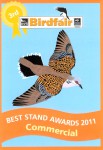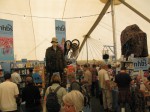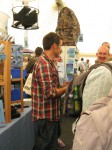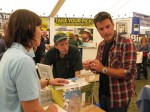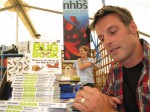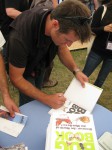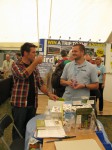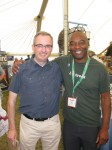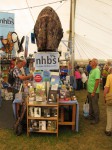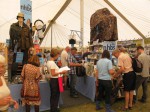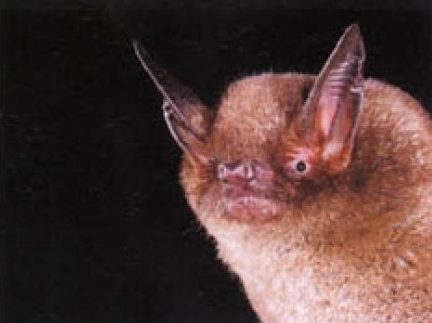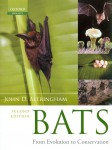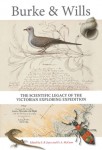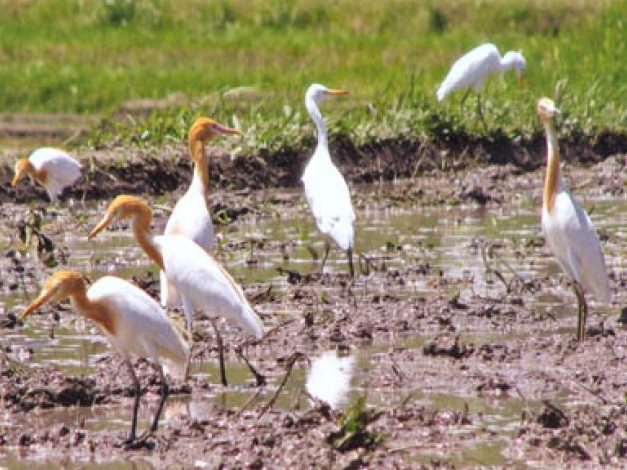“This tiny bundle of energy in my hand…”: John Altringham talks to the Hoopoe about bats
John Altringham, author of Bats: From Evolution to Conservation, discusses the appeal of bats, what they are, and how we should think about their conservation needs.
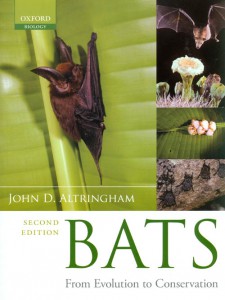 How did you first become interested in studying bats?
How did you first become interested in studying bats?
I was taken to a Natterer’s bat roost, almost 30 years ago now, and saw my first bat close up. I was a research scientist in biomechanics – trying to understand evolution’s engineering problems and solutions. This tiny bundle of energy in my hand was an engineering marvel I’d never really thought about, so I went away and read about bats. However, I didn’t read just about flight and echolocation, the subjects that came immediately to mind. As a zoologist and conservationist, I read more and more widely and became increasingly fascinated. Bats became an important ‘extra-curricular’ activity, but it was many years before they displaced biomechanics in my work. However, the seeds were most definitely sown during that very first encounter.
We all know what bats are, but – what exactly is a bat?
A bat is the only flying mammal and one of nature’s few echolocators. With these ‘skills’ it has evolved and radiated into the most diverse, the most widespread and the second most speciose group of mammals on the planet. A bat is a small mammal with the lifestyle of its much bigger cousins. It lives a long time, but only produces one baby a year. It lives within often complex social units, exhibiting complex behaviours, and makes use of the landscape on a grandiose scale through the seasons. It shows a bewildering range of ways that an animal can makes its way in the world. It is an important cog in many ecosystems, as predator, pollinator, seed disperser. Its contributions to the human economies of the world are only now being determined and appreciated. Likewise its value as an indicator of the planet’s health. It is a source of endless fascination, study and appreciation.
Why do you think there is such popular interest at this time in bat detection and conservation, and what can we learn from studying their ecology?
I really think that bats sell themselves. The formation of the bat conservation movement, some knowledgeable and enthusiastic activists and some cracking documentary footage are the catalysts in the bat conservation movement – the bats themselves do the rest, if we just show the world something of them.
Bats are also surprisingly accessible. It is relatively easy, even in suburban areas, to see and hear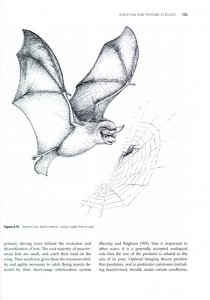 bats, sometimes at fairly close quarters – you can’t say that about many wild mammals. They often live in close proximity to humans, you don’t have to be particularly stealthy, and they just get on with life while you watch – they have a lot to offer the casual naturalist. However, there are plenty of challenges for the more dedicated naturalist.
bats, sometimes at fairly close quarters – you can’t say that about many wild mammals. They often live in close proximity to humans, you don’t have to be particularly stealthy, and they just get on with life while you watch – they have a lot to offer the casual naturalist. However, there are plenty of challenges for the more dedicated naturalist.
The need for conservation is pretty self-evident. Bats need large home ranges in connected landscapes, they rely on threatened habitats for both roosting and feeding and they are slow to recover from population setbacks. However, there are modest things we can do to help them, from practical conservation to education, which encourages widespread involvement – and success fuels further effort. Conservation needs passion and commitment – bats appear to have the charisma to generate them.
Conservation gets a big chapter in the book – it is the focus of a large and growing proportion of ecological research. There has been a lot of bridge building between research ecologists and conservation practitioners in recent years, but we still have some way to go. I’ve tried to highlight some of the issues in this chapter – evidence-based conservation is the future!
What can we learn from bats? Where do I start?! Science is all about understanding how the natural world works. Everything we learn, from the ecology of individual species to the general processes that govern the way ecosystems function, comes from the study of appropriate ‘models’. The sheer diversity of bats means that they offer useful models to study all sorts of things – just look at the topics I cover in the book.
How do you see the future for bats?
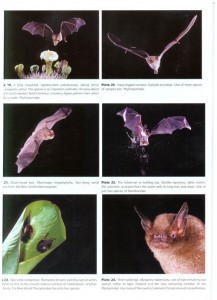 I have no idea what the future holds, for bats or the rest of biodiversity. I do think bats are among the more vulnerable animals, so looking after bats is a good way to protect other animals and plants that share their habitats. We have a growing knowledge about what we are doing wrong to our environment and what we need to do to begin to put things right. However, there is a lack of will among politicians and the ‘captains’ of commerce and industry to provide the conditions and the resources to do it. Lots of talking the talk, little walking the walk. Conservation will always be a compromise – but the balance point is far from the right place. Too many people still think of conservation in terms of what we sacrifice to achieve it, not what we gain from it. We need more objective science in conservation, alongside the passion and hard work. They provide the evidence that forces people to act and they help us to decide how to use most effectively the limited resources we have at our disposal.
I have no idea what the future holds, for bats or the rest of biodiversity. I do think bats are among the more vulnerable animals, so looking after bats is a good way to protect other animals and plants that share their habitats. We have a growing knowledge about what we are doing wrong to our environment and what we need to do to begin to put things right. However, there is a lack of will among politicians and the ‘captains’ of commerce and industry to provide the conditions and the resources to do it. Lots of talking the talk, little walking the walk. Conservation will always be a compromise – but the balance point is far from the right place. Too many people still think of conservation in terms of what we sacrifice to achieve it, not what we gain from it. We need more objective science in conservation, alongside the passion and hard work. They provide the evidence that forces people to act and they help us to decide how to use most effectively the limited resources we have at our disposal.
NHBS stock an extensive range of bat conservation equipment, supplying a range of customers from ecological consultants needing bulk stock for a construction project, to amateur naturalists keen to investigate their local bat population and do their bit for conservation.
Browse our range of bat detection equipment
NHBS Customer Services will happily discuss your needs and advise you on the best purchase for your project.
Phone: +44(0) 1803 865913
Email: customer.services@nhbs.co.uk
Book of the Week: Britain’s Plant Galls: A Photographic Guide
Continuing our selection of the very best titles available through NHBS:
Britain’s Plant Galls: A Photographic Guide
by Michael Chinery
What?
A photographic guide to the natural history and field identification of the “strange lumps and bumps that we call galls…” (Introduction, p5).
Why?
Plant galls are a great subject of research for the amateur naturalist. Bridging the sciences of botany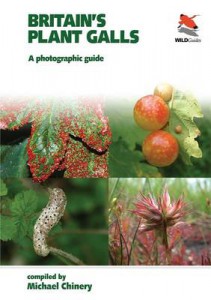 and entomology, they are a fascinating example of the symbiotic interdependence of nature, and the diversity of their size and appearance – from exquisitely attractive orb-like features and spiked swellings, to leaf blisters and discolourations – gives the interested naturalist a satisfying range of study.
and entomology, they are a fascinating example of the symbiotic interdependence of nature, and the diversity of their size and appearance – from exquisitely attractive orb-like features and spiked swellings, to leaf blisters and discolourations – gives the interested naturalist a satisfying range of study.
The reader is taken on a guided tour of the galls arranged according to their host plants for ease of identification, and there are over 200 detailed colour photographs of the commonest galls to be found among Britain’s 1,000 species. The interaction between insect and plant which results in the gall is briefly described in each case, and the book contains a general introduction to the subject.
Who?
Michael Chinery is best known for his field guides to insects and other creepy-crawlies, especially those that occur in our gardens, and for his numerous books encouraging young people to explore and enjoy the countryside and its wildlife. Insects and wild flowers fascinated him from a very early age and this led inevitably to an interest in plant galls, with their intimate mix of plant and animal life. He joined the British Plant Gall Society soon after its formation in 1985, and has been editing the Society’s journal, Cecidology, since 1990.
Announcing the Winner of the Birdfair 2011 NHBS £50 Gift Voucher Competition
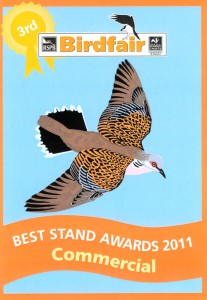
Congratulations to Bethany Simmons of Nottinghamshire who has won a £50 NHBS Gift Voucher!
Bethany says:
“Thank you very much, I loved coming to the bird show it was so different, and I loved being welcomed by everyone and I think I will give the voucher to my stepfather Kevin as I know he wants a new camera.”
We look forward to seeing Bethany, and everyone else again at Birdfair 2012…
If you’d like to purchase NHBS Gift Vouchers, click here.
A “must-have” book: What Zoos Can Do, reviewed in WAZA News
What Zoos Can Do: The Leading Zoological Gardens of Europe 2010-2020
by Anthony Sheridan
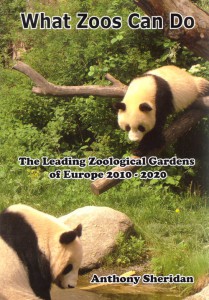 “This book contains unique information and analyses 80 leading zoological gardens in 21 European countries. This is a must-have book for all those interested in zoos – enthusiasts, sceptics, visitors, sponsors, zoo owners, politicians, wildlife conservationists and all those working in and for zoos. The book deals with a wide variety of zoo-related aspects, some of which rarely dealt with in other publications, such as the role of the zoo director, landscape design, education, ex situ and in situ conservation, marketing strategies, future plans and zoo associations. Each of the 80 zoos covered is portrayed in detail on three pages each. The book includes tables containing the evaluation of the presentaion of a number of iconic species in each of the zoos as well as ranking lists concerning visitor factors, education and conservation, and commercial and organisation.
“This book contains unique information and analyses 80 leading zoological gardens in 21 European countries. This is a must-have book for all those interested in zoos – enthusiasts, sceptics, visitors, sponsors, zoo owners, politicians, wildlife conservationists and all those working in and for zoos. The book deals with a wide variety of zoo-related aspects, some of which rarely dealt with in other publications, such as the role of the zoo director, landscape design, education, ex situ and in situ conservation, marketing strategies, future plans and zoo associations. Each of the 80 zoos covered is portrayed in detail on three pages each. The book includes tables containing the evaluation of the presentaion of a number of iconic species in each of the zoos as well as ranking lists concerning visitor factors, education and conservation, and commercial and organisation.
All the profits from the sale of this book are being donated to Stiftung Artenschutz, a German in situ conservation charity supported by more than 20 of the German and Austrian zoos covered in the book. This donation will support a specific conservation project for gibbons in Vietnam. It contains almost 400 pages with numerous full-colour photographs, maps and tables. ”
Markus Gusset,
What Zoos Can Do is distributed by NHBS
Burke and Wills and the NHBS Connection
NHBS is on Wills Road, on the edge of Totnes, a small town in Devon. Wills Road is named after William John Wills, of the Burke and Wills expedition, who famously perished in the wilds of South Australia in 1861 at the age of 27. Wills was born in Totnes, hence the name of the road, and the statue in the town centre. Robert O’Hara Burke, though not from Totnes, is also commemorated by having a road named after him, his road runs behind the NHBS warehouse; in other words we are right between the two of them.
We were reminded of Totnes’ famous son when we read the announcement of a new book recently: Burke and Wills: The Scientific Legacy of the Victorian Exploring Expedition, published by CSIRO and due to be available in the UK in November. This book deals with the scientific achievements of the expedition and its successive relief groups, rather than the much-publicised failures that led to the deaths of seven of the expedition’s members.
Regardless of the serendipitous connection between Burke & Wills and NHBS, I am rather looking forward to seeing a copy of this book, as it fills a large gap in the scientific literature of exploration, and it contains many original illustrations.
Book of the Week: Bats: From Evolution to Conservation, 2nd Ed.
Continuing our selection of the very best titles available through NHBS:
Bats: From Evolution to Conservation
by John D. Altringham
What?
2nd edition of John Altringham’s 1996 OUP publication, Bats: Biology and Behaviour
Why?
This rigorous and authoritative textbook is updated to reflect the current state of research on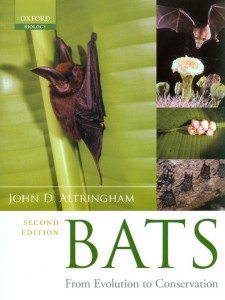 all aspects of bat biology, ecology and and conservation. Popular interest in bats is at an all-time high with many amateurs becoming involved monitoring their local bat populations and the construction industry legally bound to take their conservation needs into account, reflecting the vulnerability of this diverse and unique group.
all aspects of bat biology, ecology and and conservation. Popular interest in bats is at an all-time high with many amateurs becoming involved monitoring their local bat populations and the construction industry legally bound to take their conservation needs into account, reflecting the vulnerability of this diverse and unique group.
Bats: From Evolution to Conservation is a global study covering evolutionary biology, ecology, flight, migration, physiology and much more – and whilst presented as a text for students and researchers, its accessible and enthusiastic style means it also holds appeal for amateur naturalists and anyone interested in bat conservation.
Review of the previous edition:
“This is an excellent book from one end to the other and I highly recommend it to students and colleagues. It is a book that meets its stated goal … to use bats to illustrate processes and concepts in biology. When it comes to ecology and behaviour, he has more than succeeded … Bravo!” Journal of Animal Ecology
Who?
John D. Altringham is Professor of Animal Ecology and Conservation at the University of Leeds, UK, where he has been since 1989. He completed his BSc at the University of York, and his PhD at St. Andrews University, where he returned as a research fellow from 1983-1989. During his career he has travelled widely, studying animals as varied as tuna fish and tarantulas before focusing on bat ecology and conservation. He has published over 100 scientific papers, numerous book chapters, and two previous books: Bats: Biology and Behaviour (OUP, 1996), and British Bats (Harper Collins, 2003). He is also a regular advisor and contributor to BBC Natural History Unit productions for TV and radio, and is a member of a number of conservation advisory groups, including the Nature Conservation Panel of the National Trust. John lives on the edge of the Yorkshire Dales with his wife, Kate, and two children, Alex and Anne.
Nick Baker at NHBS – Birdfair News!
Come and meet Nick Baker at the NHBS Stand: Marquee 2, Stands 15, 33 and 34
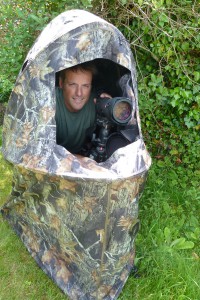 NHBS Ambassador Nick Baker will be visiting the NHBS Stand on Saturday 20th August between 12pm and 1pm, and on Sunday 21st August between 10am and 11am.
NHBS Ambassador Nick Baker will be visiting the NHBS Stand on Saturday 20th August between 12pm and 1pm, and on Sunday 21st August between 10am and 11am.
Come and talk to Nick about the wonderful world of bugs, the secret life of a TV wildlife presenter, and just how good those chair hides really are! Nick will also be signing copies of his books, including the new Nick Baker’s Bug Book: Discover the World of the Mini-Beast! which will be available at the stand.
We look forward to seeing many of you at Rutland Water over the course of next weekend!
Find out who else will be signing their books with NHBS at Birdfair 2011 here.
Book of the Week: The Urban Birder
Continuing our selection of the very best titles available through NHBS:
The Urban Birder
by David Lindo
What?
A personal account of a life’s passion for birds, seeded in the urban sprawl of 1960s London.
Why?
Urban environments are attractive to a diverse selection of bird life, with the patchwork mix of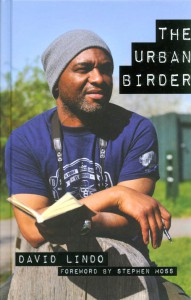 gardens and parks, rivers and reservoirs creating unique ecosystems.
gardens and parks, rivers and reservoirs creating unique ecosystems.
David Lindo has a passion for birds and in the Urban Birder he tells his story from growing up in London to adventures in Brooklyn, Hollywood and beyond. Throughout weaves the thread of his main crusade which is to encourage “urbanites to realise that there is a whole world of wildlife under their noses in the world’s cities.”
This entertaining autobiography has a simple message and is a great read, and as more people migrate to towns and cities it will become increasingly important that people learn to live alongside their avian neighbours, following David Lindo’s lead and becoming urban birders.
Who?
From the author’s website:
“I am David Lindo and I am The Urban Birder — writer, broadcaster, speaker and bird guider. My whole vibe is about getting urbanites to realise that there is a whole world of wildlife under their noses in the world’s cities.
I was a twitcher in the womb and was born clutching for a pair of binoculars. An interest in wildlife and in particular watching birds was a natural thing for me to get into, despite being surrounded by non-birders and having no mentors in my north London neighbourhood…” – read more on www.theurbanbirder.com.
David Lindo will be signing copies of The Urban Birder at Birdfair on Saturday 20th
Life with Birds – an interview with author Malcolm Smith
New from Whittles Publishing, Malcolm Smith’s Life with Birds: A Story of Mutual Exploitation zips around the world picking up sublime and ridiculous, sobering and frivolous facts from all its corners. Truly bulging with bird-lore, this makes for an engrossing read for all ornithology enthusiasts.
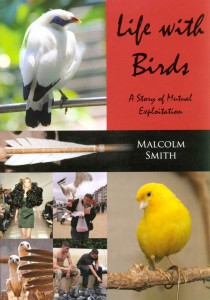 What’s your background in the bird world, and how did you first become interested in avian-human mutual relations?
What’s your background in the bird world, and how did you first become interested in avian-human mutual relations?
I think I’ve always noticed bird/human interactions wherever I’ve been – though probably more subconsciously – until I began to think about compiling and organizing them into chapters for the book.
It’s been part of a life-long interest in birds combined with a training as a biologist, though with very limited time to pursue these interests personally when I was Chief Scientist at the Countryside Council for Wales.
From a 10ft high Jackdaw nest at Eton college and the silvery bird trills of Vivaldi’s Flute Concerto in D ‘The Goldfinch’, to the 1,728 word vocabulary of Puck, the world’s most literate budgerigar, it seems there is no bird fact left out. Have you always been an intrepid collector?
Quite the contrary, there are probably just as many examples of bird/human interactions left out of my book! I’ve tried to include examples of all the major ones and many of the more unusual, bizarre and intriguing. But I had to be selective! It would be quite possible to write a whole book on birds inspiring literature and art for example but I particularly wanted to weave an interesting story using a whole range of examples to show how widespread our links are with birds.
While parts of the book have a more light-hearted, even irreverent approach, you do take a serious look at exploitation. How do you see our relationship with birds as we move through these challenging and changing times?
I think most people will continue to be oblivious to birds, almost forgetting that they eat them regularly, make use of their feathers, see them every day on their homes and in their streets, and hear them almost constantly.
I’m pretty sure that more species will take to city life, mostly causing no problems to people. But I think I have probably underestimated the future impact of city gulls – which are taking over from city pigeons – and are likely to cause more and more summer-time injuries by attacking people. Local Authorities will soon be wishing that their docile city pigeons were back! If we don’t want a growing gull problem, we need to keep our streets very much cleaner and food discard-free, something we seem to find impossible.
Human greed knows seemingly few boundaries and it’s easy to get depressed when you witness the illegal wild bird trade first hand. Unless some of the worst offending countries start acting on their international responsibilities, it’s set to continue apace.
You have plenty of interesting stories to tell – are there any bird encounters/tales featured in this book that particularly stand out for you?
Many stand out, particularly those where I had personal experience such as a Parsi funeral or collecting eiderdown from nests. But one story that does stand out particularly is that of Honeyguides leading African tribesmen to wild bee nests. I was able to gather it from a N’dorobo tribesman in northern Kenya via an Italian ornithologist working there who translated his words for me! And next week I join them both in the isolated Mathews forested mountains in Kenya. So I will be able to follow Honeyguides with Robet Lentaaya, the tribesman concerned. It’s a practice that’s dying out.
What was special, too, was the information that he can follow three different Honeyguide species, each with a different call and different response call back from the tribesman. I can’t find any mention of that anywhere in the literature!
If a reader were to take one thing away from the experience of reading Life with Birds, what would you like that to be?
That our lives and theirs remain very strongly bound together, more closely than most people would ever imagine, even in our supposedly advanced western society.

